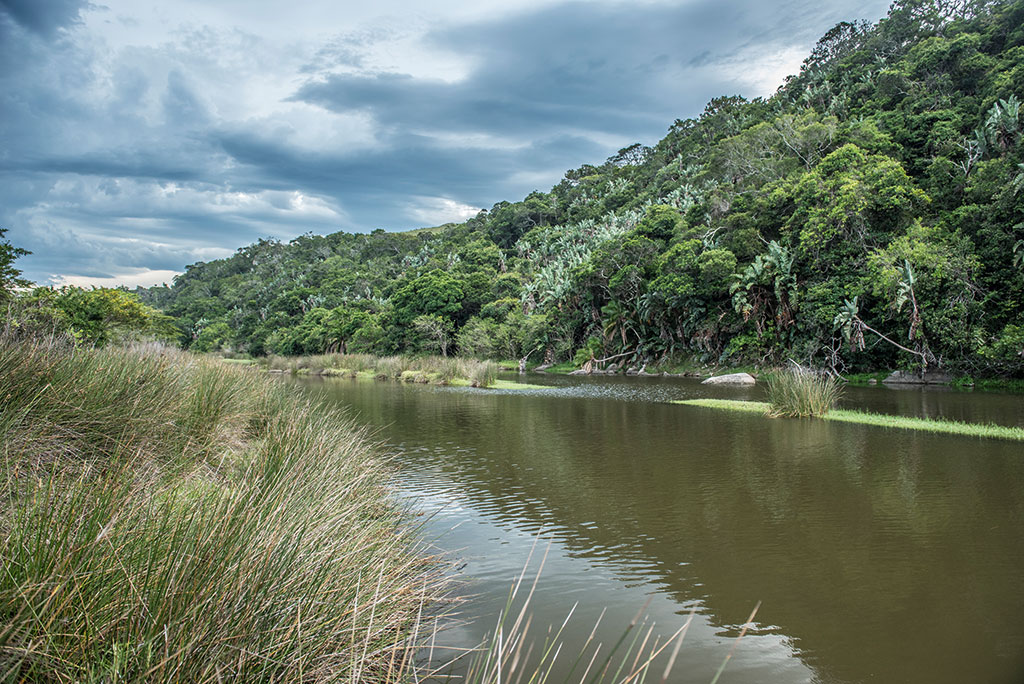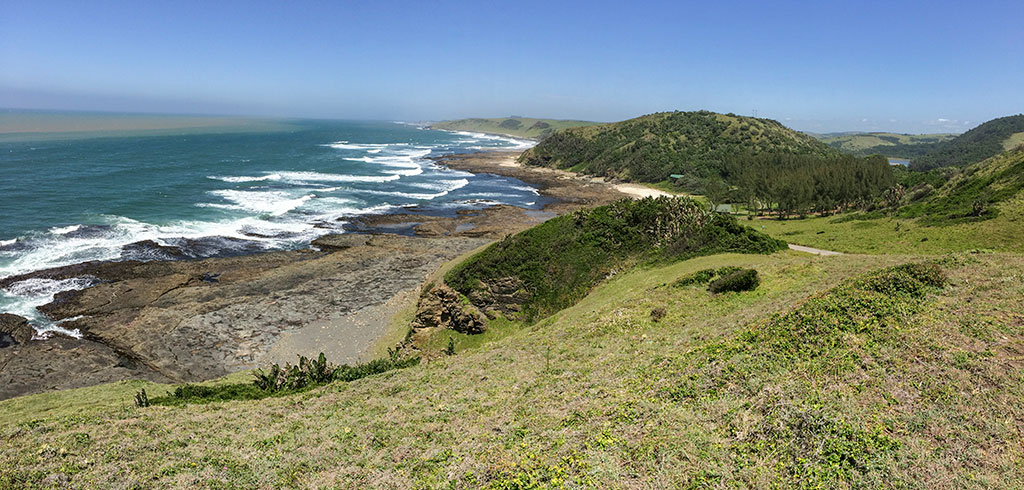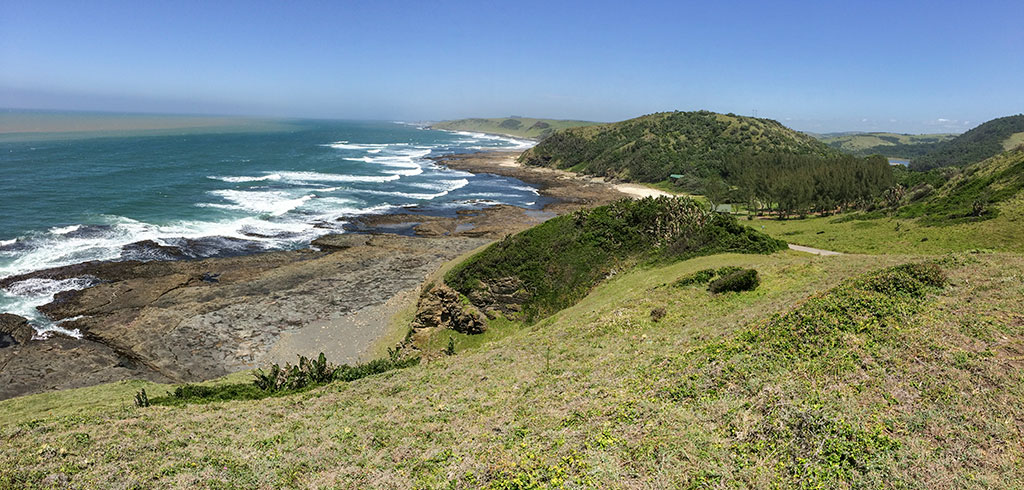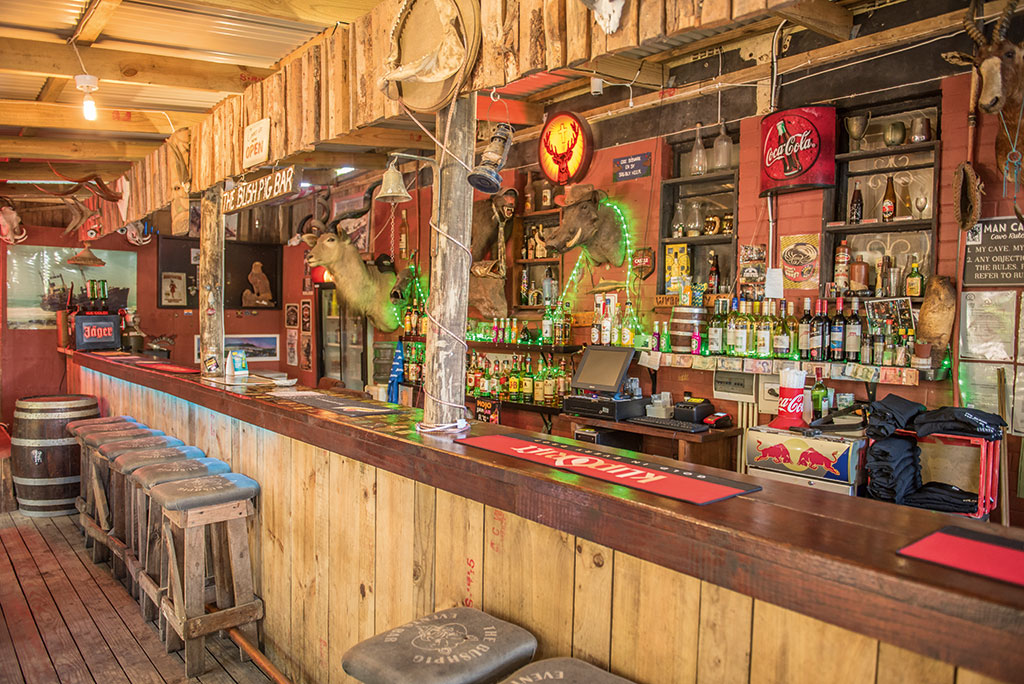The beautiful, sleepy hills between Qolora and Kei Mouth have had a turbulent past. Hunting down history, Justin Fox finds this corner of the Wild Coast is now as peaceful as can be.
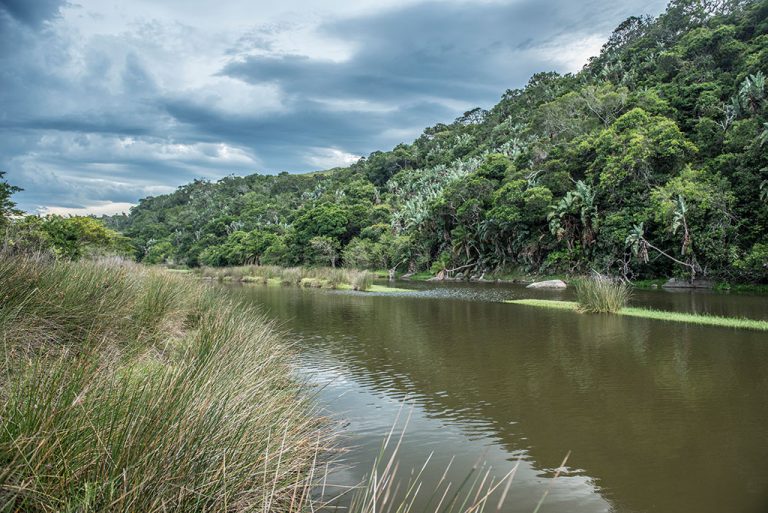
This is the pool where a 19th -century prophetess saw visions that resulted in a great disaster for her people. Image by Justin Fox
The insider
Trevor Wigley grew up at a trading store in nearby Centane, so he’s been coming to Qolora since childhood. Now he lives here and earns his keep as a local tour guide.
Trevor Wigley is a Qolora institution. When visitors roll into this Wild Coast village, chances are they’ll end up on one of Trevor’s trails within hours of arrival. I was no different. I’d come to Qolora to stay at the fine old family resort of Trennerys, explore the coast and visit the pool of Nongqawuse, famed as the prophesy site of the 19th-century cattle killings. Trevor would provide the perfect insider’s take on the area. My journey had brought me from East London to Kei Mouth, then across the Kei River on the pont ferry. It was a golden afternoon and I caught the rush-hour traffic (a dozen locals and a bakkie), chugging across the chocolate waters, bound for the old Transkei. The gravel road wended through green hills dotted with rondavels and cattle.
Coming over a rise, Qolora lay before me: a trading store, a cluster of homesteads and the sea washing a long stretch of wildbeach. I rumbled into Trennerys with its thatched cottages, undulating lawns and dense subtropical forest pressing in on all sides. I met Trevor at Trennerys reception the next morning: floppy hat, fishbowl spectacles, rosy cheeked and boyish-looking for his age. We set off in his 4×4 with Carlos Nkonki, a guide who is Trevor’s business partner and immensely knowledgeable about local fauna and flora. As Trevor had a dickey knee, Carlos would accompany me on the more taxing trails.

Cattle hang out on the beaches (here, at Trennerys) to get away from biting insects- and to tan their hides. Image by Justin Fox
We parked in a forest clearing and Carlos led us down to where a motorboat was moored. Clambering in, we puttered upriver to The Gates, a spectacular rock portal. ‘Look carefully in that cleft,’ said Carlos. ‘You’ll see a white spot. It’s a barn owl watching us.’ We glided between the cliffs, crowned hornbills flapping overhead. Coming to a landing, we clambered out and walked to a pool fed by two waterfalls – an idyllic swimming spot. Carlos climbed to the highest boulder and swallow-dived into the dark pond. I took the more sedate ladder.
Later, I sat with Trevor on a rock. He told me about growing up at a trading store in nearby Centane, and how his father had built a beach cottage in Qolora where they’d spent their holidays. ‘It was a boyhood paradise,’ he said. ‘Still is,’ I said. ‘You’re right. I bought a cottage and moved here permanently 25 years ago. Qolora is embedded in nature. My house has endless views of the waves. I used to be a surfer – conditions here are pretty wild.’ On our next outing, we drove through a vast eucalyptus plantation to Gxara Waterfall. The climb down to the falls was steep. Carlos led the way. We emerged through a clump of trees and the earth fell away at our feet. There was a weir and a pond at the head of the falls. Water tipped over the edge and disappeared into the maw. The air was filled with the heady scent of Bushman’s tea (Catha edulis); the stream glittered in the sunlight.

This is all that remains of the Jacaranda, wrecked in 1971. Image by Justin Fox
Back in the 4×4, we took a long diversion inland, down a rough track and into a thicket, until the vehicle could go no further. ‘Up ahead is Nongqawuse’s pool. She was the Xhosa girl whose prophecies – of a golden age during which the dead would arise and the white settlers would be chased into the sea – led to a millennialist movement that culminated in the great cattle killings and famine of the 1850s.’ ‘Why did the people believe her?’ I asked. ‘Her prophesies came at a time of terrible strife. People needed to believe,’ said Trevor. ‘And the power of the ancestors was very strong.’ Nongqawuse had claimed that the ancestral spirits had instructed her.
Carlos led me down a cutting to the pool where Nongqawuse had seen her visions. ‘The Unbelievers stood watching from the surrounding hills,’ he said. ‘The Believers were here in the valley. Having destroyed all their wealth, they waited and waited for the ancestors to appear. Then came starvation, death or servitude on white farms.’ The sky grew dark. Lightning split the horizon and thunder grumbled through Nongqawuse’s Valley. A forest buzzard swooped low over our heads and a troop of vervet monkeys emitted a storm of alarm calls. The murky pool, overhung by wild banana, milkwood and wild-date palms, leaked a powerful energy. The ghosts of the Believers seemed palpable. Over ensuing days, Trevor showed me more of the area. We went to Kei Mouth, home of the popular Bushpig Bar, and drove to Morgan Bay, with its fine hotel and campsite. Further south, we visited Double Mouth Nature Reserve, which has arguably the prettiest campsite in South Africa, tucked away in its own bay. Here, two rivers meet in a pristine estuary that slices through forested dunes to the sea.
On my last morning, I wanted to visit the wreck of the Jacaranda, a cargo ship that ran a ground in 1971, four kilometres up the coast from Qolora. Trevor offered to drive me but I wanted to stretch my legs. ‘How did she sink?’ I asked. ‘Oh, there are many stories,’ said Trevor. ‘One of them contends that the captain was entertaining a girlfriend of sorts in his cabin and left a 12-year-old at the helm. Engine trouble and bad weather is another explanation. An insurance scam is also a theory. It’s funny how the ship came ashore precisely on a small, sandy beach while everywhere else is treacherous rock.’ He winked. I set off after breakfast, aiming to get to the wreck at spring low tide. It was a bright, windless day. Cows lay chewing the cud on the beach. The hills were decked with yellow flowers; a green ocean thundered on the shore, producing a light mist. There were fishermen with rods, lads with their dogs. The wet sand was scored with the delicate calligraphy of bird prints. I waded through streams and climbed low bluffs until I came to the skeleton of the wreck, its bow lodged in the rocks.
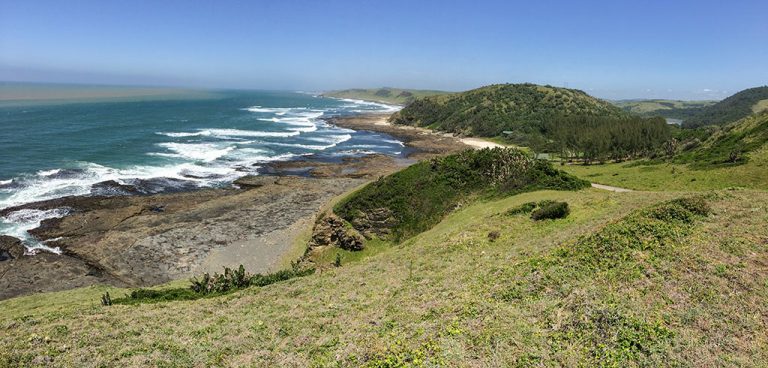
Walking trails lead north and south of Qolora Mouth along the coast. Image by Justin Fox
Turning for home, I was chivvied by the incoming tide. Negotiating a course between recumbent cows, I thought about how, despite a turbulent history, this corner of the Wild Coast is utterly peaceful. Trevor had showed me the feral cleft of The Gates, and Africa’s southernmost mangroves on the Kobonqaba River, and the Gxara River’s famous pool and waterfall. The enduring impression was one of basking tranquillity after a stormy past.
Where do locals go?
Carlos Nkonki, tour guide
‘Swimming in the pool beyond The Gates is my favourite thing to do in Qolora.’
Judi Stone, hotel manager
‘I think the beach walk from Trennerys to the wreck of the Jacaranda is simply magical.’
Rufus Hulley, owner of the trading store
‘Heading out in a ski boat and fishing along this stretch of coast is the perfect way to spend a day.’
Deoni Barnard, receptionist
‘I love visiting a local homestead, eating traditional food, drinking umqombothi, watching the kids dance … immersing myself in the local community.’
Plan your trip
Getting there
From East London, follow the N2 north-east for about 35km and turn off on the R349 to Kei Mouth. Take the ferry across the river (R80 per car, 7am to 6pm in summer, until 5.30pm in winter). Follow the road from the north bank for 11km, turn right at the T-junction and proceed for 6km to Qolora. If coming from Durban via Butterworth, on the N2 turn left at the Centane/Mazeppa sign. It’s about 28km to Centane, where you turn right at the ‘Trennerys and Seagulls Hotel’ sign. Follow this road for 26km to the coast. It’s all accessible in a normal sedan.
Stay here

Trennerys, Qolora
1. Trennerys has been a fixture on the Wild Coast for 90 years. Enjoy hearty, home-style fare, a cosy bar, tennis court, water sports and plenty of facilities for children. From R810 per person sharing DBB. Camping from R100 per person (with full use of hotel facilities).
2. Neptune’s Cove in Kei Mouth is a large house divided into five self-catering units right on the beach. From R300 per person sharing (sleeps four to six each). 0438411473
3. Double Mouth NatureReserve, 5km west of Morgan Bay, has 30 campsites on terraces above the ocean. From R225 per site. Reserve entry R10 per person. 0434920881
Do this
1. Discover Qolora with Trevor’s Trails. He has six tours that include The Gates, Kobonqaba River estuary, visiting a local Xhosa home, Gxara Waterfall and the Khoisan middens at Halls Point, a sunset cruise on the Qolora River and the ‘pool of prophesy’. From R100 per person. 0735757223
2. Walk to the shipwreck, an easy 4km north-east along the beach from Trennerys. Do it at low tide.
3. Go horse riding on the beach at Kei Mouth with Wild Coast Horseback Adventures. From R350 pp for 90 minutes. Full day rides and overnight trails also available. 0825670972
4. Abseil and climb Morgan Bay’s cliffs with Rockfacelabs. There are many short climbing routes, from grade 10 to 27, most in the moderate range. From R100 per person. 0782964906 or 0763162543
Eat here

The Bushpig Bar, Kei Mouth. Image by Justin Fox
1. The Bush pig in Kei Mouth offers hearty meals in a congenial environment (it’s part of a backpackers) and has braai facilities, a bar and tea garden. Chicken strips and chips R100; steak, salad and chips R120. 0737269322
2. Morgan Bay Hotel has two good options: formal, four course dinners in the main dining room (from R225 per person) and more casual meals at The Deck (burgers from R70, seafood platter R109). 0438411062
3. Seagulls Beach Hotel, another family hotel at Qolora Mouth, is famous for its Saturday-night seafood dinner. R185 per person. 0474980044
4. Yellowwood Forest eco retreat near Morgan Bay has wood-fired pizzas (about R75), a tea garden and bar. On Saturday mornings there is a market with food stalls. 0438411598









